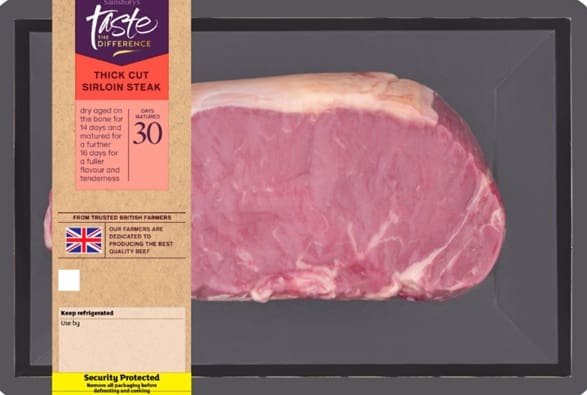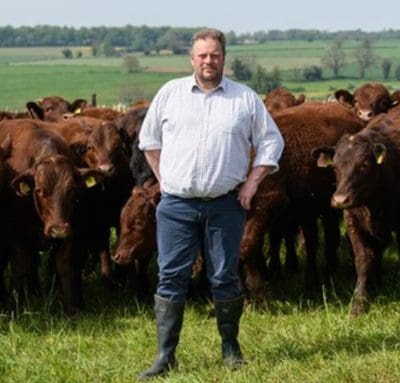Sainsbury’s 30 Days Matured British Beef Thick Cut Sirloin Steak, £13.25 (AUD $27.60) (£33.13/kg or AUD $69)
Farmers in the United Kingdom are outraged to see imported beef, including that from Australia, being sold on local supermarket shelves cheaper than their beef, claiming that the import countries have lower welfare standards.
An opinion piece by the National Farmers’ Union (NFU), a representation body for agriculture in England and Wales said retailers had reneged on their commitment to source British beef from British farms with produce such as beef from Uruguay and Australia on shelves.
“This undermines the confidence of British farmers, particularly where imported produce is potentially produced to lower welfare standards than British produce,” said NFU Livestock Board Chair, David Barton.
David Barton
“Confidence among British beef producers is already at an all-time low. The cattle population is down 1.7 percent at 7.54 million head as of April 2025.
“We need retailers and our processors to be encouraging and investing in British food and ensuring that high quality British produce has pride of place on supermarket shelves.
“The public strongly supports British farmers who produce food to the highest welfare and environmental standards.
“Clear labelling of produce is essential to ensure that consumers who value the high quality of British produce can make informed decisions and be confident about what they are purchasing.”
UK’s concerns about animal welfare in Australia
In one report from the Daily Mail it quoted World Animal Protection, a global animal welfare organisation that has an Animal Protection Index which is assessed according to 10 indicators, grouped into four goals, which address key animal welfare issues found around the world.
The four goals are:
- Recognition of animal sentience and prohibition of animal suffering
- Presence of animal welfare legislation
- Establishment of supportive government bodies
- Support for international animal welfare standards
50 countries have been given a score from A to G, with A being the best. No countries currently have an A rating, but the UK has an animal welfare standards ranking far above all the other countries – listed as B.
While Australia has a D rating along with Thailand, Kenya, Tanzania and the United States.
New Zealand, India, Mexico and many European countries are scored C.
Chris McCullough, UK-based international agricultural journalist, said farmers in the UK want meat from imported countries to meet similar welfare standards as they do.
“There has been a lot of attention on the welfare of beef cattle in the US recently, and South America, as UK farmers call for equal welfare standards for fairer marketplace competition,” he said.
“The NFU has, in the past, cited issues with Australian beef coming from feedlots, where the welfare standards do not meet the same in the UK where they are finished on grass-based systems.
“Hormone use in Australian beef production is quite a big concern for UK farmers as are long distance haulage and hot branding.”
He said imported beef is selling for close to 20pc less than the UK meat for prime cuts such as sirloin.
 “Beef prices are currently very strong in the UK, both at the farmgate and on the supermarket shelves.
“Beef prices are currently very strong in the UK, both at the farmgate and on the supermarket shelves.
“Last week the overall average price for premium beef was 633 pence per kilogram deadweight (which works out to be over $13 per kg carcass weight in Australia). Even cull cows are making 533p/kg deadweight (over $11 per kg carcass weight).”
Mr McCullough said it is mandatory for the country of rearing and the country of slaughter to be clearly labelled on meat.
Australia defends its animal welfare standards
In response to the claims Australia’s welfare standards are lower than in Britain, Cattle Australia said that sort of flawed logic was a joke.
“What rubbish to try to compare Australia’s grass-fed cattle production system with those of the UK or any other country,” said CA Chief Executive, Dr Chris Parker.
“Unlike plenty of other countries, our cattle enjoy the freedom of movement across extensive landscapes where they can express their natural behaviours.
“Our producers take animal welfare incredibly seriously and are subject to national standards and guidelines underpinned by State-based legislation.
“These include guidelines covering the safe handling of stock, animal health procedures, access to feed and water, transport, and processing.
“Adherence to these high standards of care is vital to maintaining the trust of consumers all around the world, and market access to more than 80 countries.
“Australian producers also accept their place in a global competitive market and contribute to global food security as well as animal welfare outcomes without the significant financial subsidies British beef producers receive.”
How much beef does the UK import from Australia?
Meat and Livestock Australia said in 2024 Australia exported 6,296 tonnes of beef to the UK, which was equivalent to about 0.9pc of total UK beef supply.
“Australia is one of the most efficient producers of beef in the world, which allows Australian beef to be competitive in global markets,” said an MLA spokesperson.
“Renowned for its high quality and exceptional taste, Australian beef offers outstanding value for money.
“Comparing systems between Australia and the UK is trying to compare two different systems and is very disingenuous.
“Australia delivers exceptional animal welfare outcomes, despite the regulations, systems and pathways looking different to those in the UK.”
Changes to UK subsidies pushing up the cost of meat
Mr McCullough said while subsidies still exist in the UK, the Labour government had made several shock changes to the policies around them.
“Farm subsidies keep the cost of food in the UK lower and if they disappear, those prices will shoot up, potentially leaving the door open for more cheaper food imports,” he said.
“Farmers in UK still have subsidies, but the ethos of the subsidies is changing to focus more on being paid for environmental programmes, or sustainable farming schemes rather than a headage payment or payment for number of hectares owned and farmed.”

